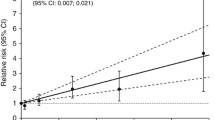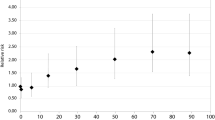The aim of this historical (retrospective) cohort study was to investigate the relation between occupational exposure to radon daughters and subsequent mortality from lung cancer. Participants were former workers from the Radium Hill uranium mine, which operated in eastern South Australia from 1952 to 1961. A total of 2,574 workers were identified from mine records. Exposures to radon daughters were estimated from historical records of radon gas concentrations in the mine and from individual job histories. Exposures of underground workers were low by comparison with other mines of that period (mean 7.0 Working Level Months [WLM], median 3.0 WLM). Thirty-six percent of the cohort could not be traced beyond the end of employment at Radium Hill. Among those traced to the end of 1987, lung cancer mortality was increased relative to the Australian national population of the period (Standardized Mortality Ratio = 194,95 percent confidence interval [CI]=142–245). Compared with surface workers, lung cancer mortality was markedly increased in the underground workers with radon daughter exposures>40 WLM (relative risk = 5.2, CI=1.8–15.1). From the available information, we conclude that this increase is unlikely tobe due to differences in smoking habits or other confounders. Taken together with the findings from other occupational studies, these results support current moves towards more stringent radiation control in the workplace, and underline the importance of research into the possible effects of domestic radon exposures.
Similar content being viewed by others
References
Samet JM, Hornung RW. Review of radon and lung cancer risk. Risk Analysis 1990; 10(1): 65–75.
Cohen BL. Variation of radon levels in US homes correlated with house characteristics, location, and socioeconomic factors. Health Physics 1991; 60: 631–42.
Lubin JH, Boice JD. Estimating Rn-induced lung cancer in the United States. Health Physics 1989; 57: 417–27.
Howe GR, Nair RC, Newcombe HB, et al. Lung cancer mortality (1950–80) in relation to radon daughter exposure in a cohort of workers at the Eldorado Beaverlodge uranium mine. INCI 1986; 77(2): 357–62.
Radford EP, St. Clair Renard KG. Lung cancer in Swedish iron miners exposed to low doses of radon daughters. N Engl J Med 1984; 310(23): 1485–94.
Committee on the Biological Effects of Ionizing Radiations. Health Risks of Radon and Other Internally Deposited Alpha-emitters (BEIR IV). Washington, DC: National Academy Press; 1988.
Howe GR, Nair RC, Newcombe HB et al. Lung cancer mortality (1950–80) in relation to radon daughter exposure in a cohort of workers at the Eldorado Port Radium uranium mine: possible modification of risk by exposure rate. JNCI 1987; 79: 1255–60.
Sevc J, Kunz E, Tomasek L; Placek V, Horecek J. Cancer in man after exposure to Rn daughters. Health Physics 1988; 54: 27–46.
Beckman, R, Holub, R. Radon Daughter Growth with Continuous Radon Influx. Washington DC: United States Department of Labor, Pub. IR 1099.
Frome EL, Checkoway H. Use of Poisson regression models in estimating incidence rates and ratios. Am J Epidemiol 1985; 121: 309–23.
Pearce N, Checkoway H. A simple computer program for generating person-time data in cohort studies involving time-related factors. Am J Epidemiol 1987; 125: 1085–91.
Hill DJ. Australian patterns of tobacco smoking in 1986. Med J Aust 1988; 149; 6–10.
Axelson O. Aspects on confounding in occupational health epidemiology. Scand J Work Environ Health 1978; 4: 85–9.
Woodward A, Roder DM, McMichael AJ, Lewis SY. Ionising radiation and cancer incidence in uranium miners: an historical cohort study. In: Hogstedt C, Reuterwall C, eds. Proceedings of the Sixth International Symposium of Epidemiology in Occupational Health, 16–19 August 1988. Amsterdam: Elsevier Press, 1988: 129–32.
Additional information
Dr Woodward, Professor McMicbael and ms Mylvaganam are with the Department of Community Medicine, University of Adelaide, GPO Box 498, South Australia 5001. Dr Roder is with the Epidemiology Branch, South Australian Health Commission, South Australia. Dr Crouch is with the Radiation Protection Branch, South Australian Health Commission. Address correspondence to Dr Woodward. This work was supported by grants from the National Occupational Health and Safety Commission (Worksafe Australia) and the Anti-Cancer Foundation of South Australia. Ms Mylvaganam bolds a National Health and Medical Research Council Public Health Research and Development Fellowship.
Rights and permissions
About this article
Cite this article
Woodward, A., Roder, D., McMichael, A.J. et al. Radon daughter exposures at the Radium Hill uranium mine and lung cancer rates among former workers, 1952–87. Cancer Causes Control 2, 213–220 (1991). https://doi.org/10.1007/BF00052136
Received:
Accepted:
Issue Date:
DOI: https://doi.org/10.1007/BF00052136




